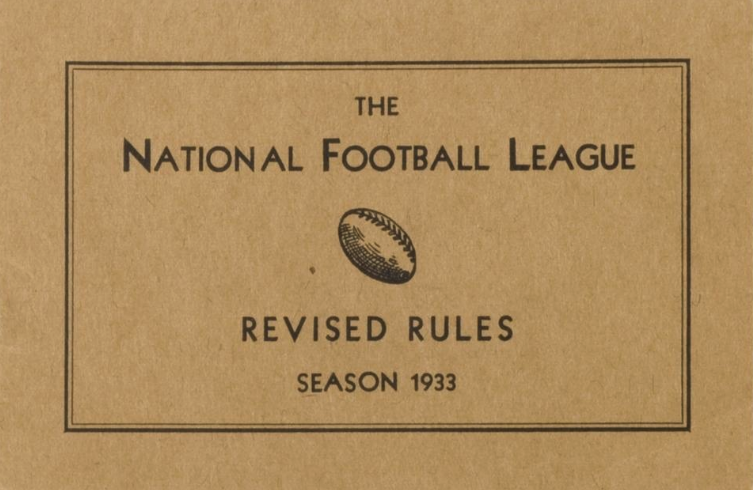Passing Through Time, a 1930s Rule Change Started the NFL on its Way to Wide Open Offense
7/31/2018
The forward pass has been a legal practice in the game of professional football since 1906. George “Peggy” Parratt of the Massillon Tigers holds the distinction as being the first man in pro football history to successfully complete a pass. Parratt hooked up with end Dan “Bullet” Riley against the combined Benwood-Moundsville, W. Va. team on Oct. 25 that year.
The rule change to allow passing was predicated by the college rule book. Pro football at the time, mostly because there was no organized league, strictly adhered to the college rules of the day.
At that time, however, the passing game did not resemble the air-it-out type of attack that teams operate today. In fact, the rules in place didn’t really encourage the pass at all. To legally pass the ball, the thrower had to be at least 5 yards behind the line of scrimmage. The penalty if this rule was not adhered to: a turnover to the defense. The rules even stipulated that if a pass was incomplete and untouched by either team the ball would also turn over to the defense.
Many tweaks to the passing rules occurred over the years since the practice was legalized. The biggest may have been in 1933 when the National Football League, which had formed in 1920 and had operated under the college rules, finally developed its own rule book. That year the league made provisions to allow a forward pass from anywhere behind the line of scrimmage as opposed to the 5-yard buffer requisite.

This change grew out of a controversial touchdown pass thrown by Chicago Bears Hall of Fame fullback Bronko Nagurski in the 1932 indoor playoff game that decided the ’32 league title. In that game against the Portsmouth Spartans (who later became the Detroit Lions), Nagurski faked a run toward the line and then quickly threw a TD pass to Red Grange. The Spartans contested that Nagurski was not 5 yards behind the line when he fired the pass. The play stood, and the Bears later added a safety to put the final touches on a 9-0 victory.
At the league meetings the next offseason, Spartans coach George “Potsy” Clark lobbied for a change in the rules to allow passes anywhere behind the line of scrimmage as he argued “because Nagurski will do it anyway!”
Over the next several hours, sweeping changes were made to the NFL’s playing rules. Chief among the revisions was the sixth motion of the meeting. Per the official meeting minutes from that session, which are a part of the collection in the Pro Football Hall of Fame’s Ralph Wilson, Jr. Pro Football Research and Preservation Center, Boston Redskins owner George Preston Marshall made the motion that was seconded by Chicago Bears owner George Halas.
″... the rule covering the use of the forward pass, whereby it is necessary for the passer to be at least five yards behind the line of scrimmage before he can pass the ball, be changed permitting the passer to pass the ball from any point behind the line of scrimmage.”
The motion was passed unanimously and with that the NFL entered a new era with a more wide-open style of play.
Unencumbered by the rules, it wasn’t long before the league had its first 1,000-yard passer. That came in 1936 when the Green Bay Packers Arnie Herber threw 173 times for 1,239 yards. Another Packers QB became the NFL’s first 2,000-yard passer, when Cecil Isbell completed 146 of 268 passes for 2,021 yards in 1942.
It wasn’t until the 1960 season that pro football finally had a passer eclipse 3,000 yards through the air in one season. In fact, it had two. Johnny Unitas of the NFL’s Baltimore Colts and Jack Kemp of the American Football League’s Los Angeles Chargers both threw for over 3,000 yards that season.
Seven seasons later, Joe Namath of the New York Jets became the first to eclipse 4,000 yards through the air. He accomplished that feat in 1967. Another 4,000-yard passer didn’t surface until Dan Fouts in 1979. Five years later in 1984, Dan Marino became the first player in history to reach 5,000 yards passing in a single season.
The forward pass has come a long way from its modest beginnings over 100 years ago. Year after year it becomes more and more integral to the strategy of the game, while captivating fans from a screen pass and check down to every long bomb and “Hail Mary.” The NFL has seen passing yardage soar in every decade of its existence. From the 69,444 passing yards that were gained from 1933-39 (Note: the first seven years the statistic was officially compiled) to the 1,135,331 yards gained 2000-09. As Hall of Famer and Green Bay Packer founder, player and coach Curly Lambeau once said, “I’d rather pass. I figured it was the easiest way to pick up yards.”
Go back to all blog listings

